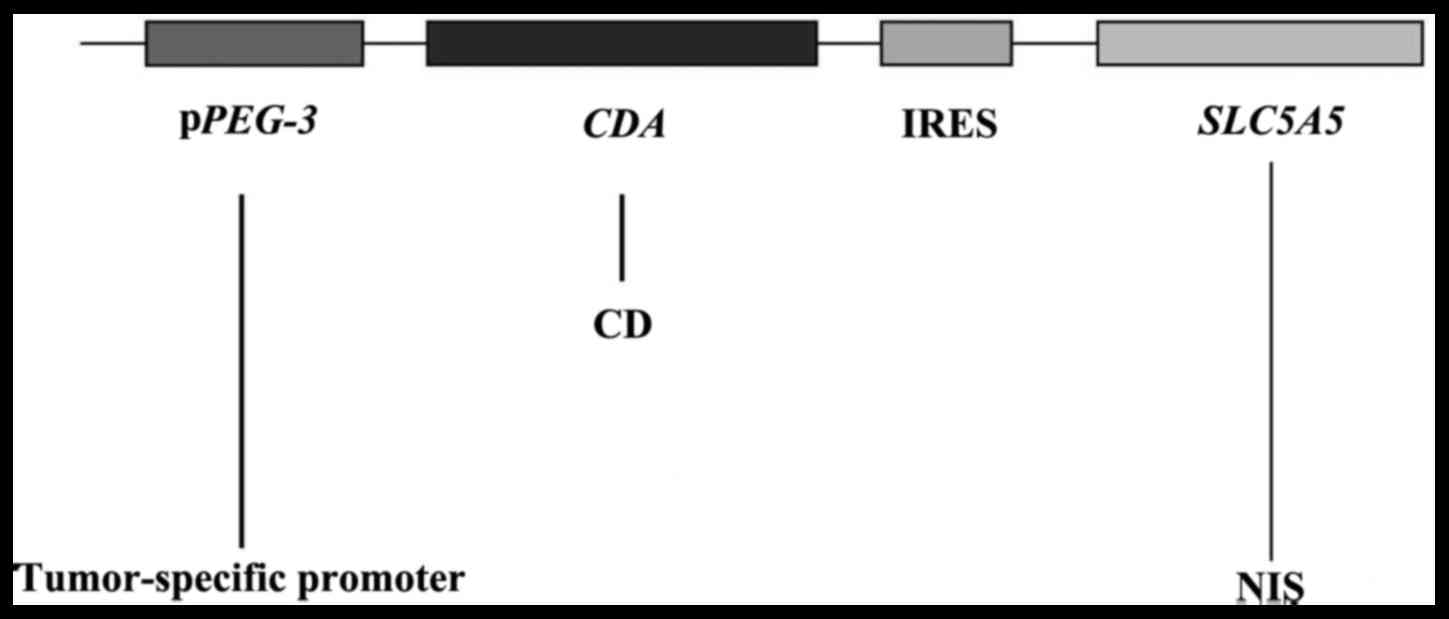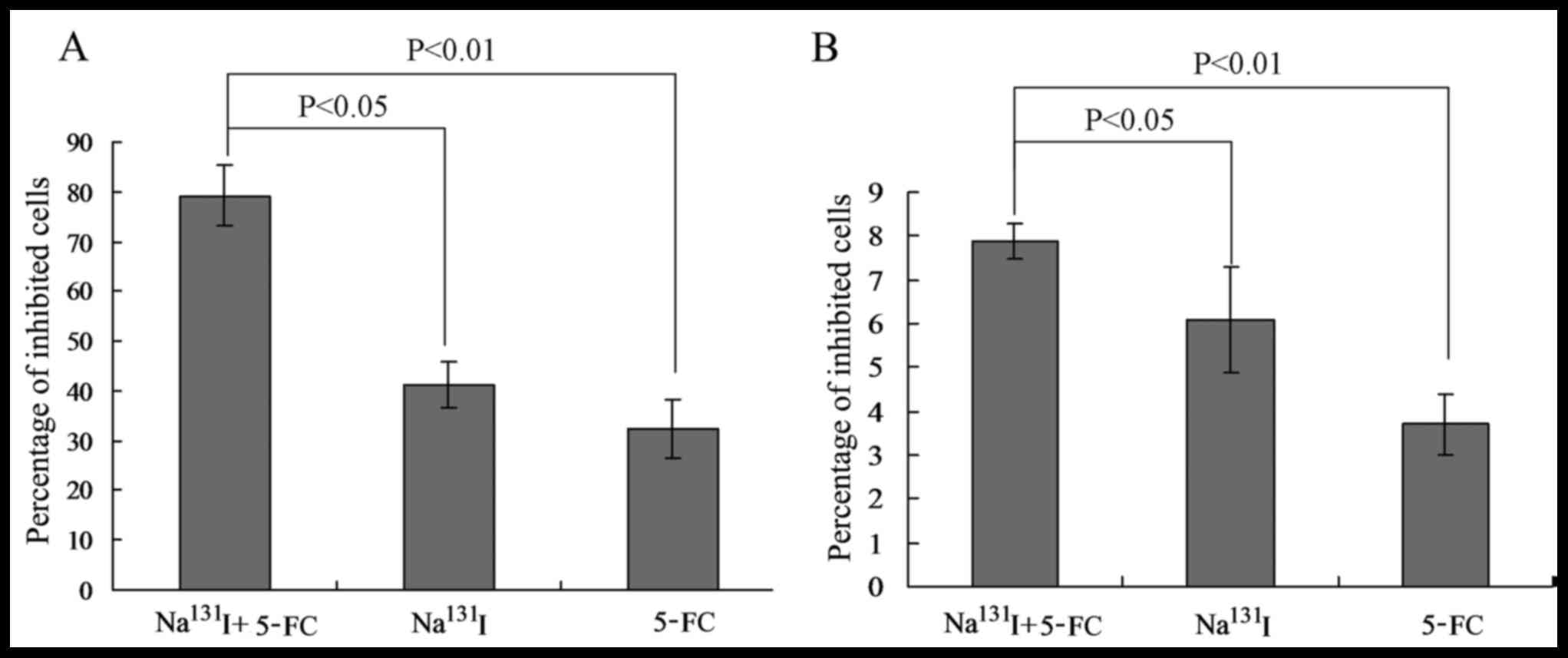|
1
|
Wartofsky L: Increasing world incidence of
thyroid cancer: Increased detection or higher radiation exposure?
Hormones (Athens). 9:103–108. 2010. View Article : Google Scholar : PubMed/NCBI
|
|
2
|
Wang C, Lu S, Jiang J, Jia X, Dong X and
Bu P: Has-microRNA-101 suppresses and invasion by targeting Rac1 in
thyroid cancer cells. Oncol Lett. 8:1815–1821. 2014.PubMed/NCBI
|
|
3
|
Xing M: BRAF mutation in thyroid cancer.
Endocr Relat Cancer. 12:245–262. 2005. View Article : Google Scholar : PubMed/NCBI
|
|
4
|
Romagnoli S, Moretti S, Voce P and Puxeddu
E: Targeted molecular therapies in thyroid carcinoma. Arq Bras
Endocrinol Metab. 53:1361–1073. 2009. View Article : Google Scholar
|
|
5
|
Lin SF, Huang YY, Lin JD, Chou TC, Hsueh C
and Wong RJ: Utility of a PI3K/mTOR Inhibitor (NVP-BEZ235) for
thyroid cancer therapy. PLoS One. 7:e467262012. View Article : Google Scholar : PubMed/NCBI
|
|
6
|
Gild ML, Bullock M, Robinson BG and
Clifton-Bligh R: Multikinase inhibitors: A new option for the
treatment of thyroid cancer. Nat Rev Endocrinol. 7:617–624. 2011.
View Article : Google Scholar : PubMed/NCBI
|
|
7
|
Khan MS, Pandith AA, Hussain M, Iqbal M,
Khan NP, Wani KA, Masoodi SR and Mudassar S: Lack of mutational
events of RAS genes in sporadic thyroid cancer but high risk
associated with HRAS T81C single nucleotide polymorphism
(case-control study). Tumor Biol. 34:521–529. 2013. View Article : Google Scholar
|
|
8
|
Yazawa K, Fisher WE and Brunicardi FC:
Current Progress in Suicide Gene Therapy for Cancer. World J Surg.
26:783–789. 2002. View Article : Google Scholar : PubMed/NCBI
|
|
9
|
Springer CJ and Niculescu-Duvaz I:
Prodrug-activating systems in suicide gene therapy. J Clin Invest.
105:1161–1167. 2010. View
Article : Google Scholar
|
|
10
|
Wang Z, Wang B, Guo H, Shi G and Hong X:
Clinicopathological significance and potential drug target of
T-cadherin in NSCLC. Drug Des Devel Ther. 9:207–316.
2014.PubMed/NCBI
|
|
11
|
Chung JK: Sodium iodide symporter: Its
role in nuclear medicine. J Nucl Med. 43:1188–1200. 2002.PubMed/NCBI
|
|
12
|
Guerrieri F, Piconese S, Lacoste C,
Schinzari V, Testoni B, Valogne Y, Gerbal-Chaloin S, Samuel D,
Bréchot C, Faivre J and Levrero M: The sodium/iodide symporter NIS
is a transcriptional target of the p53-family members in liver
cancer cells. Cell Death Dis. 4:e8072013. View Article : Google Scholar : PubMed/NCBI
|
|
13
|
McCormick F: Cancer gene therapy: Fringe
or cutting edge? Nat Rev Cancer. 1:130–141. 2001. View Article : Google Scholar : PubMed/NCBI
|
|
14
|
Breyer B, Jiang W, Cheng HW, Zhou L, Paul
R, Feng T and He TC: Adenoviral vector-mediated gene transfer for
human gene therapy. Curr Gene Ther. 1:49–162. 2001. View Article : Google Scholar
|
|
15
|
Aschebrook-Kilfoy B, Grogan RH, Ward MH,
Kaplan E and Devesa SS: Follicular thyroid cancer indicence
patterns in the Unites States, 1980–2009. Thyroid. 23:1015–1021.
2013. View Article : Google Scholar : PubMed/NCBI
|
|
16
|
Lazar V, Bidart JM, Caillou B, Mahé C,
Lacroix L, Filetti S and Schlumberger M: Expression of the Na+/I-
symporter gene in human thyroid tumors: A comparison study with
other thyroid-specific genes. J Clin Endocrinol Metal.
84:3228–3234. 1999. View Article : Google Scholar
|
|
17
|
Zhu Y, Cheng M, Yang Z, Zeng CY, Chen J,
Xie Y, Luo SW, Zhang KH, Zhou SF and Lu NH: Mesenchymal stem
cell-based NK4 gene therapy in nude mice bearing gastric cancer
xenografts. Drug Des Devel Ther. 8:2449–2462. 2014. View Article : Google Scholar : PubMed/NCBI
|
|
18
|
Xie L, Semenciw R and Mery L: Cancer
incidence in Canada: Trends and projections (1983–2032). Health
Promot Chronic Dis Prev Can. 35 Suppl 1:S2–S186. 2015.(In English,
French). View Article : Google Scholar
|
|
19
|
Maxwell JE, Sherman SK, O'Dorision TM and
Howe JR: Medical management of metastatic medullary thyroid cancer.
Cancer. 120:3287–3301. 2014. View Article : Google Scholar : PubMed/NCBI
|
|
20
|
National Cancer Institute, . SEER stat
fact sheets: Thyroid cancer. http://seer.cancer.gov/statfacts/html/thyro.htmlJanuary
12–2015
|
|
21
|
Yip L: Molecular markers for thyroid
cancer diagnosis, prognosis, and targeted therapy. J Surg Oncol.
111:43–50. 2015. View Article : Google Scholar : PubMed/NCBI
|
|
22
|
Chai LP, Wang ZF, Liang WY, Chen L, Chen
D, Wang AX and Zhang ZQ: In vitro and in vivo effect of 5-FC gene
therapy with TNF and CD suicide gene on human laryngeal carcinoma
cell line Hep-2. PLoS One. 8:e611362013. View Article : Google Scholar : PubMed/NCBI
|
|
23
|
Kogai T and Brent GA: The sodium iodide
symporter (NIS): Regulation and approaches to targeting for cancer
therapeutics. Phamacol Ther. 135:355–370. 2012. View Article : Google Scholar
|
|
24
|
Bentires-Alj M, Hellin AC, Lechanteur C,
Princen F, Lopez M, Fillet G, Gielen J, Merville MP and Bours V:
Cytosine deaminase suicide gene therapy for peritoneal
carcinomatosis. Cancer Gene Ther. 7:20–26. 2000. View Article : Google Scholar : PubMed/NCBI
|
|
25
|
Kucerova L, Skolekova S, Demkova L,
Bohovic R and Matuskova M: Long-term efficiency of mesenchymal
stromal cell-mediated CD-MSC/5-FC therapy in human melanoma
xenograft model. Gene Ther. 21:874–887. 2014. View Article : Google Scholar : PubMed/NCBI
|
|
26
|
Zimmer AM, Kazikiewicz JK, Rosen ST and
Spies SM: Chromatographic evaluation of the radiochemical purity of
Na131I: Effect on monoclonal antibody labeling. Int J Rad Appl
Instrum B. 14:533–534. 1987. View Article : Google Scholar : PubMed/NCBI
|
|
27
|
Su ZZ, Shi Y and Fisher PB: Subtraction
hybridization identifies a transformation progression-associated
gene PEG-3 with sequence homology to a growth arrest and DNA
damage-inducible gene. Proc Natl Acad Sci USA. 94:pp. 9125–9130.
1997, View Article : Google Scholar : PubMed/NCBI
|
|
28
|
Su ZZ, Goldstein NI, Jiang H, Wang MN,
Duigou GJ, Young CS and Fisher PB: PEG-3, a nontransforming cancer
progression gene, is a positive regulator of cancer aggressiveness
and angiogenesis. Proc Natl Acad Sci USA. 96:pp. 15115–15120. 1999,
View Article : Google Scholar : PubMed/NCBI
|
|
29
|
Goers L, Freemont P and Polizzi KM:
Co-culture systems and technologies: Taking synthetic biology to
the next level. J R Soc Interface. 11:201400652014. View Article : Google Scholar : PubMed/NCBI
|
|
30
|
Livak KJ and Schmittgen TD: Analysis of
relative gene expression data using real-time quantitative PCR and
the 2(-Delta Delta C(T)) method. Methods. 25:402–408. 2001.
View Article : Google Scholar : PubMed/NCBI
|
|
31
|
Pacholska A, Wirth T, Samaranayake H,
Pikarainen J, Ahmad F and Ylä-Herttuala S: Increased invasion of
malignant gliomas after 15-LO-1 and HSV-tk/ganciclovir combination
gene therapy. Cancer Gene Ther. 19:870–874. 2012. View Article : Google Scholar : PubMed/NCBI
|
|
32
|
Hsiao HT, Xing L, Deng X, Sun X, Ling CC
and Li GC: Hypoxia-targeted triple suicide gene therapy
radiosensitizes human colorectal cancer cells. Oncol Rep.
32:723–729. 2014. View Article : Google Scholar : PubMed/NCBI
|
|
33
|
Li C, Penet MF, Wildes F, Takagi T, Chen
Z, Winnard PT, Artemov D and Bhujwalla ZM: Nanoplex delivery of
siRNA and prodrug enzyme for multimodality image-guided molecular
pathway targeted cancer therapy. ACS Nano. 4:6707–6716. 2010.
View Article : Google Scholar : PubMed/NCBI
|
|
34
|
Watanabe M, Nasu Y and Kumon H:
Adenovirus-mediated REIC/Dkk-3 gene therapy: Development of an
autologous cancer vaccination therapy (Review). Oncol Lett.
7:595–601. 2014.PubMed/NCBI
|













